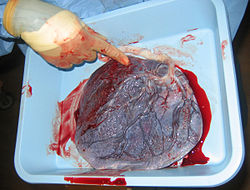Placenta
The placenta is a temporary organ that connects the developing fetus via the umbilical cord to the uterine wall.
It allows nutrient uptake, thermo-regulation, waste elimination, and gas exchange via the mother's blood supply; to fight against internal infection; and to produce hormones which support pregnancy.
The placenta produces two steroid hormones – oestrogen and progesterone. Progesterone acts to maintain pregnancy by supporting the lining of the uterus (womb), which provides the environment for the fetus and the placenta to grow. Progesterone prevents the shedding of this lining (similar to that which occurs at the end of a menstrual cycle), since this would result in pregnancy loss. Progesterone also suppresses the ability of the muscular layer of the uterine wall to contract, which is important in preventing labour from occurring before the end of pregnancy. Oestrogen levels rise towards the end of pregnancy. Oestrogen acts to stimulate the growth of the uterus to accommodate the growing fetus and allows the uterus to contract by countering the effect of progesterone. In this way, it prepares the uterus for labour. Oestrogen also stimulates the growth and development of the mammary glands during pregnancy, in preparation for breastfeeding.

Placenta |

Human placenta from just after birth with the umbilical cord in place |

The placenta functions as a fetomaternal organ with two components:[2] the fetal placenta (Chorion frondosum), which develops from the same blastocyst that forms the fetus, and the maternal placenta (Decidua basalis), which develops from the maternal uterine tissue.[3] It metabolizes a number of substances and can release metabolic products into maternal or fetal circulations. The placenta is expelled from the body upon birth of the fetus.
Placentas probably first evolved about 150 million to 200 million years ago. The protein syncytin, which makes up the physical barrier between mother and baby in the syncytiotrophoblast, has a certain RNA signature in its genome that has led to the hypothesis that it originated from an ancient retrovirus: essentially a "good" virus that helped pave the transition from egg-laying to live-birth.[4]